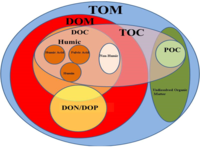
Exploring drivers of litter decomposition in a greening Arctic: results from a transplant experiment across a treeline
Sign Up to like & getrecommendations! Published in 2018 at "Ecology"
DOI: 10.1002/ecy.2442
Abstract: Abstract Decomposition of plant litter is a key control over carbon (C) storage in the soil. The biochemistry of the litter being produced, the environment in which the decomposition is taking place, and the community… read more here.
Keywords: biochemistry; litter; tundra; environment ... See more keywords

Nutrient availability measurement techniques in arctic tundra soils: in situ ion exchange membranes compared to direct extraction
Sign Up to like & getrecommendations! Published in 2020 at "Plant and Soil"
DOI: 10.1007/s11104-020-04658-2
Abstract: The use of ion exchange membranes (IEMs) as an alternative to direct chemical extractions for measuring soil nutrient availability has many theoretical advantages but was not well-investigated in the arctic. We compared the two methods… read more here.
Keywords: extraction; plant; tundra; nutrient availability ... See more keywords

Detection of tundra trail damage near Barrow, Alaska using remote imagery
Sign Up to like & getrecommendations! Published in 2017 at "Geomorphology"
DOI: 10.1016/j.geomorph.2016.09.013
Abstract: Abstract In the past several decades, the use of all-terrain vehicles (ATVs) has proliferated in many Arctic communities in North America. One example is the village of Barrow, Alaska. This coastal community has only local… read more here.
Keywords: imagery; trail; tundra; damage ... See more keywords

Chloroform (CHCl3) Emissions From Coastal Antarctic Tundra
Sign Up to like & getrecommendations! Published in 2021 at "Geophysical Research Letters"
DOI: 10.1029/2021gl093811
Abstract: In this study, the first in situ static‐chamber measurements were conducted at coastal Antarctica tundra for CHCl3 fluxes, which showed that CHCl3 was naturally emitted from the Antarctic tundra at 35 ± 27 nmol m−2… read more here.
Keywords: antarctic tundra; tundra; chcl3 emissions; chcl3 emission ... See more keywords

Road dust biases NDVI and alters edaphic properties in Alaskan arctic tundra
Sign Up to like & getrecommendations! Published in 2019 at "Scientific Reports"
DOI: 10.1038/s41598-018-36804-3
Abstract: Increased road-building activity in the arctic has the potential to impact adjacent ecosystems. Roads in permafrost regions are often built atop insulative gravel pads that generate dust plumes, altering soil chemistry and ecosystem function of… read more here.
Keywords: tundra; road dust; road; deposition ... See more keywords

Strong isoprene emission response to temperature in tundra vegetation
Sign Up to like & getrecommendations! Published in 2022 at "Proceedings of the National Academy of Sciences of the United States of America"
DOI: 10.1073/pnas.2118014119
Abstract: Significance How ecosystem–atmosphere exchange of reactive hydrocarbons, biogenic volatile organic compounds (BVOCs), responds to climate change may provide important feedbacks on the regional climate. We combined direct measurements with model predictions of ecosystem-scale fluxes of… read more here.
Keywords: tundra vegetation; temperature; tundra; strong isoprene ... See more keywords

Delineation of the forest-tundra ecotone using texture-based classification of satellite imagery
Sign Up to like & getrecommendations! Published in 2020 at "International Journal of Remote Sensing"
DOI: 10.1080/01431161.2020.1734254
Abstract: ABSTRACT The transition zone between the boreal forest and Arctic tundra, the forest-tundra ecotone (FTE), is an area of high ecological and climatological significance. Despite its importance, a globally consistent high spatial resolution mapping is… read more here.
Keywords: texture based; classification; tundra; forest tundra ... See more keywords

21st century tundra shrubification could enhance net carbon uptake of North America Arctic tundra under an RCP8.5 climate trajectory
Sign Up to like & getrecommendations! Published in 2018 at "Environmental Research Letters"
DOI: 10.1088/1748-9326/aabf28
Abstract: Author(s): Mekonnen, ZA; Riley, WJ; Grant, RF | Abstract: © 2018 The Author(s). Published by IOP Publishing Ltd. Recent observed shifts in Arctic tundra shrub cover have uncertain impacts on 21st century net ecosystem carbon… read more here.
Keywords: carbon; tundra; 21st century; arctic tundra ... See more keywords

Using structure to model function: incorporating canopy structure improves estimates of ecosystem carbon flux in arctic dry heath tundra
Sign Up to like & getrecommendations! Published in 2023 at "Environmental Research Letters"
DOI: 10.1088/1748-9326/acceb6
Abstract: Most tundra carbon flux modeling relies on leaf area index (LAI), generally estimated from measurements of canopy greenness using the normalized difference vegetation index (NDVI), to estimate the direction and magnitude of fluxes. However, due… read more here.
Keywords: carbon flux; tundra; structure; canopy structure ... See more keywords

Biogenic silica accumulation varies across tussock tundra plant functional type
Sign Up to like & getrecommendations! Published in 2017 at "Functional Ecology"
DOI: 10.1111/1365-2435.12912
Abstract: Summary 1.Silica (SiO2) accumulation by terrestrial vegetation is an important component of the biological silica cycle because it improves overall plant fitness and influences export rates of silica from terrestrial to marine systems. However, most… read more here.
Keywords: accumulation; plant; tundra; silica ... See more keywords

Peak season carbon exchange shifts from a sink to a source following 50+ years of herbivore exclusion in an Arctic tundra ecosystem
Sign Up to like & getrecommendations! Published in 2017 at "Journal of Ecology"
DOI: 10.1111/1365-2745.12654
Abstract: Summary To date, the majority of our knowledge regarding the impacts of herbivory on arctic ecosystem function has been restricted to short-term ( read more here.
Keywords: carbon; term; tundra; ecosystem ... See more keywords